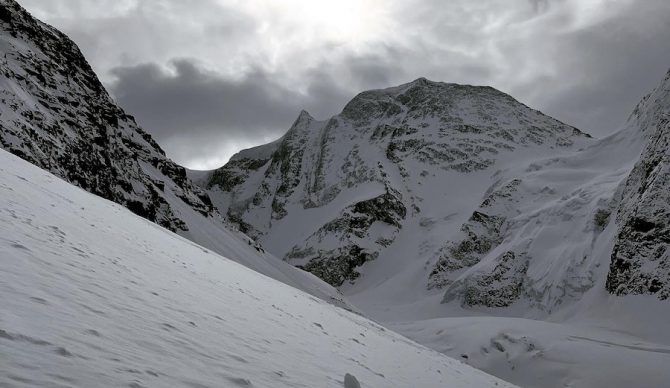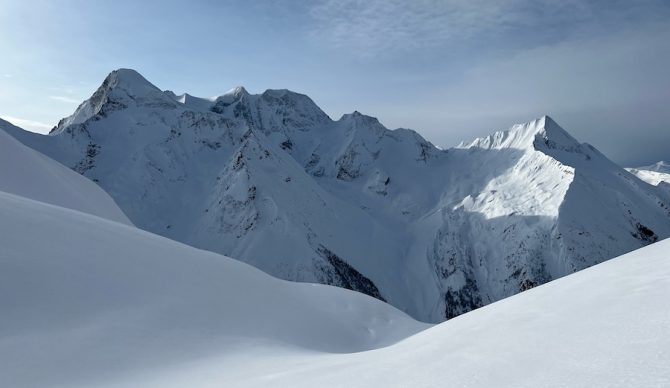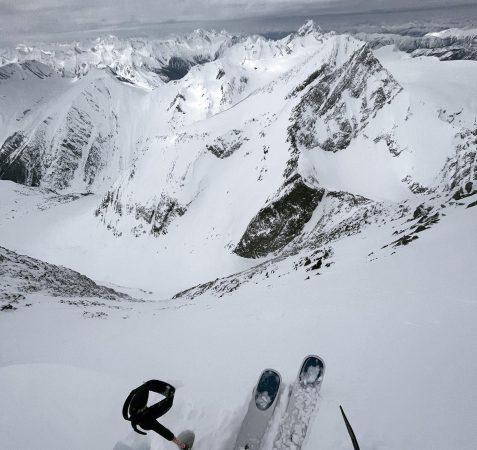
Comstock, looking formidable. Yes, it’s that gnarly looking chute in the center of the image. Photo: Michael Wirth.
You may or may not have heard of the Fifty Classic Ski Descents of North America. It’s a book, written by Chris Davenport, Art Burrows, and Penn Newhard, that outlines the 50 best and biggest lines from Alaska to California, including lines off of iconic peaks like Mt. Whitney, Mt. Baker, Grand Teton, and Denali. Any ski mountaineer worth their salt would know the book, but it has since received more mainstream attention thanks to pro skier Cody Townsend’s “THE FIFTY Project,” dedicated to skiing all 50 of the lines from the book.
One such line is known as the Comstock Couloir. Off of Mt. Dawson, a peak deep in the Selkirk Mountains of British Columbia. Comstock Couloir has been skied exactly once in recorded history by ski-mountaineer Greg Hill and four others in 2008 (documented in the video below). Now, 14 years later, Mike Wirth just recorded the second descent of Comstock Couloir, ever, by himself. Not even Cody Townsend has skied the line yet. I got him on the phone to hear about his exploits, and what makes Comstock such a difficult objective.
Congratulations, what a huge achievement! What is it about Comstock that has kept others from claiming the second descent?
Well, it’s a big line. You know, the line itself is 2,500 feet of beautifully consistent 55 degree slope, which is pretty steep. But I think the main reason it hasn’t been skied much is because it’s really far out there. Just to get to the top of the couloir you have to travel 13 miles and ascend about 10,500 feet. So that’s a big mission. I think one of the other reasons is that it has some complex glacier travel. The way that Greg Hill and those guys did it was they went up and around on the hanging glacier of Dawson, summited it, and then descended to the Comstock. I went up the Comstock, which had some risks involved.
Like what, for example?
So the Comstock has a pretty decent cornice that forms at the top, and with cornices there’s always the danger of it breaking. However, in my mapping analysis, I realized the couloir is cambered in a way where slough and cornice break will funnel down the climber’s left side of the Comstock – I could actually see this happening while I was climbing up it. So I took a very precise route on the climber’s right side of couloir which kept me protected until the last 300 feet when I used a rock ridge to traverse to a smaller couloir on the right of Comstock proper, and since that mini-couloir didn’t have a cornice on top of it, I was able to get to the top from there.
I chose that route because of the fact I was solo and wanted to minimize my time on a hanging glacier, which is very dangerous to travel on as a soloist. And compared to the glacier crossing, going directly up the couloir is much shorter.

The objective, still a long ways away on Asulkan Pass. Photo: Michael Wirth.
So what were some other pros and cons of going solo?
Well, If something goes drastically wrong, if I’m out there solo and I break my leg, yeah, I’d be in a really bad spot. But for smaller mishaps, say I take too long to complete the line and have to bivouac at the bottom, I went out there with enough food and a small bivvy sack in preparation for possibly having to spend the night. Like I said one of the main complications with the line is the fact that it’s so far out there, and the Selkirk Mountains are big. So you have a lot of terrain that you’re going over.
On the way out you have to cross over Asulkan Pass, and I did that around 8 a.m. on the way into the mountains, but it faces south, so wet slides are a serious concern for the way out. After I got to the top of Comstock, I skied the couloir and the 4,000 feet of awesome powder below it back to a protected tree area where I left my bivvy sack and enough food to last the night. I hung out there for a while waiting for it to refreeze while listening to wet slides happening all around me in that valley, and then, once it was cold enough, made my way out.

From the top. Photo: Michael Wirth.
So, are you now in competition with Cody Townsend in any way?
No, not at all. Cody has always been a big inspiration for me, and I think he’s inspiring a ton of people to get outside and go backcountry skiing and do it safely. More recently he’s become a bit of a mentor as well. He’s someone that knows more about the mountains than I do because he’s had more time in them and the opportunity to learn from people who know a lot more than both of us. And this is a really dangerous sport. You’re competing against the mountains, which will always be bigger and better than you. So it’s our individual goals to try to make ourselves the best as we possibly can be, to rise to the challenge that the mountains pose to us.
Something that we’ve talked a bit about, especially after Comstock, is this theory, which is called the “normalization of deviance.” And essentially, what it comes down to for backcountry skiing is that if we take on dangerous and risky activities with no consequence, time and time again, our psychologies will develop a bias to assuming those activities are safe, even though they’re not. And so while I’m really excited to have skied the Comstock Couloir after it stood dormant for 14 years, I need to remember that this expedition included some serious risks. And while that’s what’s required to push boundaries in extreme sports, most importantly it’s not something that can be done every day and we need to remind ourselves and absorb that and not just move on to the next, harder objective, but take some time to chill out, too.
You’ve definitely earned a nice long rest after this one.
Thanks, Will.
Editor’s Note: Follow Michael Wirth’s adventures in the mountains (including his current project of climbing and skiing the 31 of the Fifty Classic Ski Descents in the continental U.S.), give him a follow, here.

